
Deep Space 1 (DS1) was a NASA technology demonstration spacecraft which flew by an asteroid and a comet. It was part of the New Millennium Program, dedicated to testing advanced technologies.
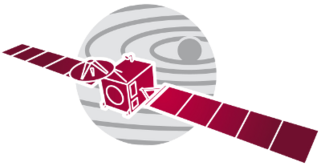
Rosetta was a space probe built by the European Space Agency launched on 2 March 2004. Along with Philae, its lander module, Rosetta performed a detailed study of comet 67P/Churyumov–Gerasimenko (67P). During its journey to the comet, the spacecraft performed flybys of Earth, Mars, and the asteroids 21 Lutetia and 2867 Šteins. It was launched as the third cornerstone mission of the ESA's Horizon 2000 programme, after SOHO / Cluster and XMM-Newton.

New Horizons is an interplanetary space probe launched as a part of NASA's New Frontiers program. Engineered by the Johns Hopkins University Applied Physics Laboratory (APL) and the Southwest Research Institute (SwRI), with a team led by Alan Stern, the spacecraft was launched in 2006 with the primary mission to perform a flyby study of the Pluto system in 2015, and a secondary mission to fly by and study one or more other Kuiper belt objects (KBOs) in the decade to follow, which became a mission to 486958 Arrokoth. It is the fifth space probe to achieve the escape velocity needed to leave the Solar System.

Pluto Kuiper Express was an interplanetary space probe that was proposed by Jet Propulsion Laboratory (JPL) scientists and engineers and under development by NASA. The spacecraft was intended to be launched to study Pluto and its moon Charon, along with one or more other Kuiper belt objects (KBOs). The proposal was the third of its kind, after the Pluto 350 and a proposal to send a Mariner Mark II spacecraft to Pluto.
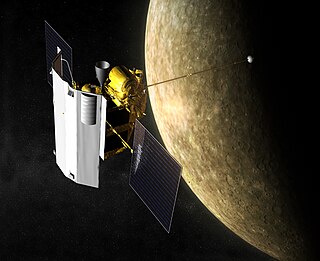
MESSENGER was a NASA robotic space probe that orbited the planet Mercury between 2011 and 2015, studying Mercury's chemical composition, geology, and magnetic field. The name is a backronym for Mercury Surface, Space Environment, Geochemistry, and Ranging, and a reference to the messenger god Mercury from Roman mythology.

Rosetta is a space probe designed to rendezvous with the comet 67P/Churyumov–Gerasimenko, perform flybys of two asteroids, and carry lander Philae until its landing on 67P. This page records a detailed timeline of this mission.
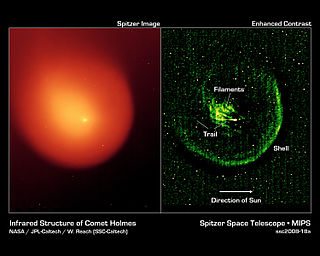
The coma is the nebulous envelope around the nucleus of a comet, formed when the comet passes near the Sun in its highly elliptical orbit. As the comet warms, parts of it sublimate; this gives a comet a diffuse appearance when viewed through telescopes and distinguishes it from stars. The word coma comes from the Greek κόμη (kómē), which means "hair" and is the origin of the word comet itself.

Sol Alan Stern is an American engineer, planetary scientist and space tourist. He is the principal investigator of the New Horizons mission to Pluto and the Chief Scientist at Moon Express.

The exploration of Pluto began with the arrival of the New Horizons probe in July 2015, though proposals for such a mission had been studied for many decades. There are no plans as yet for a follow-up mission, though follow-up concepts have been studied.

486958 Arrokoth (provisional designation 2014 MU69; formerly nicknamed Ultima Thule) is a trans-Neptunian object located in the Kuiper belt. Arrokoth became the farthest and most primitive object in the Solar System visited by a spacecraft when the NASA space probe New Horizons conducted a flyby on 1 January 2019. Arrokoth is a contact binary 36 km (22 mi) long, composed of two planetesimals 21 and 15 km (13 and 9 mi) across, that are joined along their major axes. With an orbital period of about 298 years and a low orbital inclination and eccentricity, Arrokoth is classified as a cold classical Kuiper belt object.
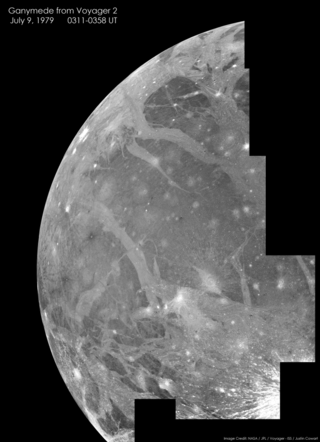
A flyby is a spaceflight operation in which a spacecraft passes in proximity to another body, usually a target of its space exploration mission and/or a source of a gravity assist to impel it towards another target. Spacecraft which are specifically designed for this purpose are known as flyby spacecraft, although the term has also been used in regard to asteroid flybys of Earth for example. Important parameters are the time and distance of closest approach.
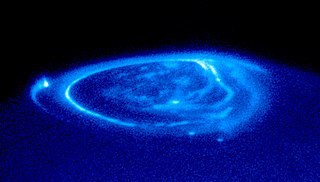
UVS, known as the Ultraviolet Spectrograph or Ultraviolet Imaging Spectrometer is the name of an instrument on the Juno orbiter for Jupiter. The instrument is an imaging spectrometer that observes the ultraviolet range of light wavelengths, which is shorter wavelengths than visible light but longer than X-rays. Specifically, it is focused on making remote observations of the aurora, detecting the emissions of gases such as hydrogen in the far-ultraviolet. UVS will observes light from as short a wavelength as 70 nm up to 200 nm, which is in the extreme and far ultraviolet range of light. The source of aurora emissions of Jupiter is one of the goals of the instrument. UVS is one of many instruments on Juno, but it is in particular designed to operate in conjunction with JADE, which observes high-energy particles. With both instruments operating together, both the UV emissions and high-energy particles at the same place and time can be synthesized. This supports the Goal of determining the source of the Jovian magnetic field. There has been a problem understanding the Jovian aurora, ever since Chandra determined X-rays were coming not from, as it was thought Io's orbit but from the polar regions. Every 45 minutes an X-ray hot-spot pulsates, corroborated by a similar previous detection in radio emissions by Galileo and Cassini spacecraft. One theory is that its related to the solar wind. The mystery is not that there are X-rays coming Jupiter, which has been known for decades, as detected by previous X-ray observatories, but rather why with the Chandra observation, that pulse was coming from the north polar region.

The Europa Ultraviolet Spectrograph (Europa-UVS) is an ultraviolet spectrograph imager that will be flown on board the Europa Clipper mission to Jupiter's moon Europa. The Europa-UVS will be able to detect small erupting plumes and will provide data about the composition and dynamics of Europa's thin exosphere.

Harold Anthony "Hal" Weaver, Jr. is an American astronomer, known for his research into the composition of solar system bodies including comets and Kuiper belt objects.

Ralph is a science instrument aboard the robotic New Horizons spacecraft, which was launched in 2006. Ralph is a visible and infrared imager and spectrometer to provide maps of relevant astronomical targets based on data from that hardware. Ralph has two major subinstruments, LEISA and MVIC. MVIC stands for Multispectral Visible Imaging Camera and is a color imaging device, while LEISA originally stood for Linear Etalon Imaging Spectral Array and is an infrared imaging spectrometer for spaceflight. LEISA observes 250 discrete wavelengths of infrared light from 1.25 to 2.5 micrometers. MVIC is a pushbroom scanner type of design with seven channels, including red, blue, near-infrared (NIR), and methane.

Long Range Reconnaissance Imager (LORRI) is a telescope aboard the New Horizons spacecraft for imaging. LORRI has been used to image Jupiter, its moons, Pluto and its moons, and Arrokoth since its launch in 2006. LORRI is a reflecting telescope of Ritchey-Chrétien design, and it has a main mirror diameter of 208 mm across. LORRI has a narrow field of view, less than a third of a degree. Images are taken with a CCD capturing data with 1024 × 1024 pixels. LORRI is a telescopic panchromatic camera integrated with the New Horizons spacecraft, and it is one of seven major science instruments on the probe. LORRI does not have any moving parts and is pointed by moving the entire New Horizons spacecraft.

Pluto Energetic Particle Spectrometer Science Investigation (PEPSSI), is an instrument on the New Horizons space probe to Pluto and beyond, it is designed to measure ions and electrons. Specifically, it is focused on measuring ions escaping from the atmosphere of Pluto during the 2015 flyby. It is one of seven major scientific instruments aboard the spacecraft. The spacecraft was launched in 2006, flew by Jupiter the following year, and went onto flyby Pluto in 2015 where PEPSSI was able to record and transmit back to Earth its planned data collections.
Hibernation of spacecraft is an operating mode used when regular operations are suspended for an extended period of time but restarting is expected. On long duration and deep space missions it saves power or other limited resources and extends mission life. The term is substantially similar to the hibernation mode used in computer power saving.



















